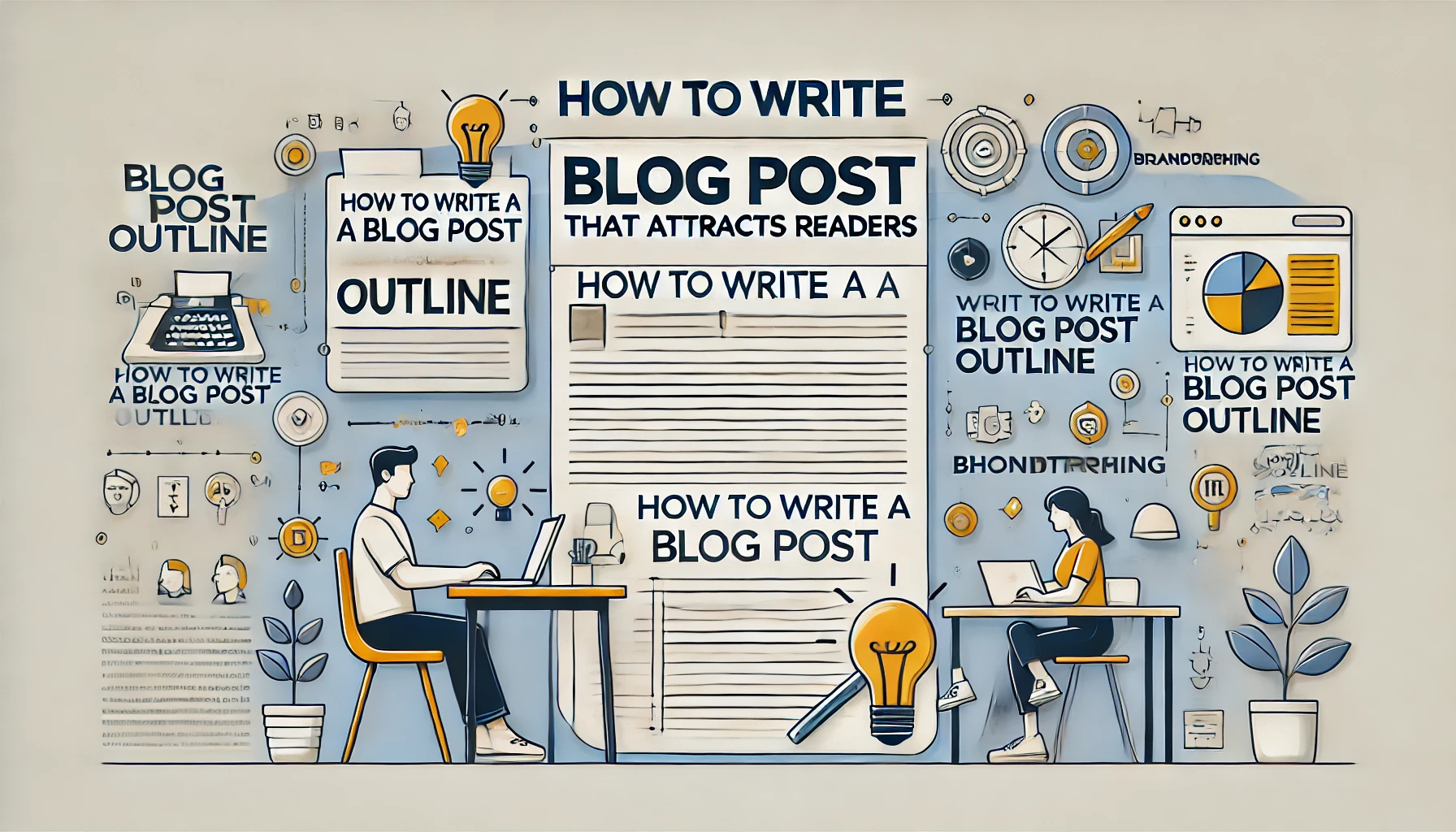Table of Contents
Are you struggling to figure out how to write a blog post outline that truly attracts readers? In this article, we’ll answer questions about crafting an effective outline, organizing your thoughts, and optimizing content to keep readers engaged.
By the end, you’ll have actionable strategies to create blog post outlines that ensure clarity, appeal, and SEO success.
Understand The Purpose Of A Blog Post Outline
A blog post outline serves as a roadmap for your content, helping you stay organized and focused. It ensures your ideas flow logically and provides structure to keep your readers engaged from start to finish.
Define The Role Of A Blog Post Outline
An outline is like a foundation for your blog post, guiding your content’s development. I believe it simplifies the writing process by breaking down complex ideas into manageable parts. It also helps you identify gaps in your research or arguments.
A good outline acts as a blueprint, helping you maintain consistency in tone and style. You can also use it to prioritize key points, ensuring that essential topics stand out. By doing this, you create content that resonates with your readers and meets their expectations.
Using an outline saves time during writing and editing. When you know exactly what to write and where to place it, you can focus on crafting meaningful content instead of wrestling with structure. I find this approach especially helpful for longer posts.
In addition, an outline ensures that your content meets SEO requirements. By planning where to place keywords and subheadings, you can optimize your blog post effectively without overloading it with unnecessary repetitions.
Benefits Of Using A Structured Outline
A structured outline helps you focus on your audience’s needs and ensures your post remains coherent. It serves as a checklist to ensure all critical points are covered. I recommend using outlines to avoid writer’s block and boost productivity.
When you use a structured outline, it’s easier to repurpose content. For example, a well-organized blog post can be transformed into a video script, infographic, or social media posts. This not only saves effort but amplifies your content’s reach.
A structured outline also improves reader engagement. By presenting information in an organized way, you make it easier for readers to find what they’re looking for. They’re more likely to stay on the page and absorb your content.
Moreover, structured outlines help with collaboration. If you’re working with a team, sharing an outline ensures everyone is on the same page about the content direction. This eliminates misunderstandings and streamlines the content creation process.
How Outlines Help Readers And Writers
Outlines act as a bridge between your ideas and your readers. I believe that by using an outline, you can tailor your content to address specific reader pain points. It ensures your message is clear, engaging, and valuable.
For writers, outlines provide a clear pathway to navigate complex topics. This reduces the time spent reworking sections that don’t fit. You can focus on crafting each paragraph without worrying about how it connects to the rest of the post.
Readers benefit from well-outlined content because it’s easier to follow. Organized sections with descriptive headings allow them to skim through the post and find the information they need quickly. This makes your content more reader-friendly.
In addition, outlines help balance depth and brevity. Writers can expand on key ideas while keeping the overall post concise. This ensures that your blog provides value without overwhelming your audience with unnecessary details.
Connecting The Outline To Blog Goals
Your blog outline should always align with your objectives. For example, if your goal is to drive traffic, I suggest prioritizing SEO elements like keywords and engaging headlines. If it’s to educate, focus on thorough research and structured explanations.
Outlines also ensure that your content supports your brand’s voice. Whether you aim to entertain, inform, or persuade, an outline keeps your messaging consistent. This builds trust and credibility with your audience over time.
Another way to connect outlines to goals is by identifying key takeaways for readers. Ask yourself: What do I want my audience to learn or do after reading this? Incorporate these insights into your outline to keep your content purposeful.
Lastly, using outlines for goal alignment helps measure success. When you review your post’s performance, you can trace its effectiveness back to the planning stage. I recommend this practice to continuously refine your content strategy.
Research And Analyze Reader Needs

Understanding your audience is the cornerstone of creating a blog post outline that resonates. By researching their needs, preferences, and search intent, you can craft content that feels personalized and valuable to them.
How To Identify Target Audience Preferences
To identify your audience’s preferences, start by considering their pain points and interests. I suggest creating detailed personas to understand their goals, challenges, and what they value most in content. This sets the stage for targeted blogging.
Social media and forums are great tools for learning about audience preferences. Observe the questions they ask and the discussions they engage in. This provides real-world insights into what topics they care about and how they consume information.
Surveys and polls are another effective way to gather feedback. Ask your audience directly about what they’d like to read. I’ve found that even simple questions can uncover valuable ideas for blog content.
Incorporate insights from your research into your outline. For instance, if your audience prefers practical tips, dedicate sections of your outline to actionable advice. This makes your blog more appealing and relevant to readers.
Using Keyword Research For Blog Outlines
Keyword research is an essential part of crafting an effective blog outline. It helps you identify what your audience is searching for. I recommend tools like Google Keyword Planner or SEMrush to find high-traffic, low-competition keywords.
Integrate primary and secondary keywords into your outline strategically. Place them in your headings, subheadings, and introductory paragraph to optimize visibility. But ensure that they fit naturally into the content flow.
Long-tail keywords are particularly useful for niche topics. These phrases capture specific search intent and help your blog rank higher. Incorporate them into your outline to address detailed reader queries effectively.
Keyword research also reveals trends in your niche. This helps you align your outline with current topics of interest. By staying updated, you can create timely and relevant blog posts that resonate with your audience.
Tools To Analyze Search Intent Effectively
Search intent is the reason behind a reader’s query. Understanding it ensures that your content satisfies their expectations. I recommend using tools like AnswerThePublic or Ubersuggest to uncover questions your audience is asking.
Google’s “People also ask” section is a valuable resource for search intent analysis. Incorporate these queries into your outline to ensure your content addresses common concerns. This improves both reader satisfaction and SEO performance.
Review analytics from past blog posts to identify patterns in search behavior. This data helps refine your outline, making it more relevant. For example, if readers often search for how-to guides, include detailed step-by-step sections in your post.
By understanding search intent, you can align your outline with what readers need most. I believe this approach not only attracts readers but keeps them engaged, as your content directly answers their questions.
Aligning Topics With Reader Expectations
To align your topics with reader expectations, focus on clarity and relevance. Use your outline to highlight the key benefits readers will gain. I suggest writing headings and subheadings that immediately convey value and attract attention.
Explore your competitors’ content to identify gaps you can fill. Look for topics that your audience seeks but aren’t adequately covered elsewhere. Incorporate these insights into your outline to stand out.
Use analytics tools to track how readers engage with your existing posts. Patterns in time spent, bounce rates, and comments provide clues about what they expect. Refine your outlines based on this data to improve content performance.
Always keep your audience’s goals in mind. Whether they’re looking for information, inspiration, or solutions, ensure your outline addresses these needs. I find that this personalized approach makes readers feel seen and understood.
Structure Your Blog Post Outline Properly
Structuring your blog post outline properly ensures your content flows logically and keeps readers engaged. A well-organized outline acts as a roadmap, helping you stay on track while delivering clear, valuable information to your audience.
Start With A Compelling Blog Title
A strong title grabs attention and sets expectations for your content. I recommend creating a title that is specific, clear, and includes the primary keyword. This ensures your blog post is easy to find and resonates with readers.
Compelling titles often include numbers, action verbs, or power words that evoke curiosity. For instance, “10 Proven Tips to Create a Blog Post Outline That Attracts Readers” immediately tells the reader what they’ll gain. Keep your title concise but impactful.
Your title also sets the tone for your outline. If it’s a how-to guide, ensure the sections flow in a step-by-step manner. If it’s a listicle, organize points in a logical order. This makes writing easier and your content more engaging.
Lastly, test your title by asking whether it clearly reflects your blog’s value. I believe this small step can significantly improve click-through rates and reader engagement.
Divide Content Into Logical Sections
Breaking your content into clear sections enhances readability and helps readers navigate easily. Use your blog post outline to map out these sections, ensuring each one focuses on a specific aspect of your topic.
Each section should be cohesive, with subheadings that act as signposts for your readers. I suggest organizing your points in a way that mirrors your audience’s journey—from introduction to actionable takeaways. This keeps them engaged throughout.
Logical divisions also prevent overwhelming your audience. Instead of presenting everything at once, distribute information evenly across sections. This makes your content digestible and encourages readers to keep scrolling.
When dividing sections, consider adding transition sentences that guide readers smoothly from one idea to the next. This not only improves flow but also enhances the overall reading experience.
Tips For Creating Engaging Subheadings
Engaging subheadings entice readers to continue reading and improve your SEO. I recommend using subheadings that include keywords naturally while sparking curiosity or providing a clear benefit. This makes your content skimmable and appealing.
Power words like “Proven,” “Effective,” or “Essential” in subheadings draw attention. For example, “Essential Tips for Structuring a Blog Post Outline” highlights the value readers will gain. Ensure your subheadings accurately represent the content beneath them.
Your subheadings should also reflect the hierarchy of information in your blog post outline. I find that starting with broad concepts and narrowing down to specifics keeps readers engaged and ensures comprehensive coverage of the topic.
Experiment with questions or problem-solving phrases as subheadings. For instance, “How Do You Create Engaging Subheadings?” directly addresses a reader’s query, making them more likely to read that section.
Balancing Content Depth And Readability
Balancing depth and readability ensures your blog is both informative and accessible. I suggest using your outline to prioritize key points while simplifying complex ideas into clear, actionable steps for your audience.
Break down technical concepts into relatable examples or analogies. This makes your blog more engaging and ensures that readers of all expertise levels can understand the content. Your outline should highlight areas where explanations need simplification.
While diving deep into your topic, avoid overwhelming readers with lengthy paragraphs or excessive jargon. Use bullet points, numbered lists, or visuals to present detailed information in a reader-friendly way.
Always focus on your audience’s needs. Ask yourself: What information will they find most useful? By answering this question within your outline, you ensure a perfect balance between depth and readability.
Integrate Keywords Seamlessly Into The Outline

Keywords play a vital role in optimizing your blog post outline for search engines. Placing them strategically ensures your content ranks well while remaining natural and engaging for readers.
Importance Of Using Primary Keywords Early
Using primary keywords early signals to search engines and readers what your content is about. I recommend incorporating the keyword in the first 100 words of your post, preferably in the introduction, to set a clear focus.
Including the keyword early establishes relevance and improves SEO. It also reassures readers that your content addresses their query. For example, starting with “Learn how to write a blog post outline that attracts readers” makes your intent clear.
Avoid forcing keywords into sentences. Instead, integrate them naturally into the context. I find that crafting sentences around the keyword rather than inserting it into existing text improves flow and readability.
Early keyword placement also helps set the tone for the rest of the blog. It acts as a guide for the structure and ensures consistency in addressing the primary topic throughout the post.
Where To Place Keywords In Your Outline
Strategic keyword placement in your outline maximizes SEO benefits. Use the primary keyword in H2 headings, H3 subheadings, and the first few sentences of each section to reinforce relevance without overusing it.
For headings, I recommend placing keywords where they make the most sense. For instance, in “How to Write a Blog Post Outline That Engages Readers,” the keyword fits naturally while highlighting the blog’s value.
In body text, scatter keywords throughout while maintaining a conversational tone. I believe readers appreciate when content feels natural and not overly optimized for search engines. Balance is key to keeping them engaged.
Use variations of the primary keyword to avoid repetition and capture additional search intent. For example, phrases like “blog outline creation” or “effective blog post outlines” diversify your SEO reach without diluting the content’s focus.
Avoiding Keyword Stuffing While Optimizing
Keyword stuffing not only hurts readability but also lowers your content’s credibility. I suggest focusing on delivering value first and letting keywords flow naturally. Readers prioritize clarity and usefulness over repeated phrases.
To avoid keyword stuffing, monitor the frequency of your primary keyword in your content. Tools like Rank Math can help ensure you’re using it effectively without overdoing it. I recommend aiming for a natural density of around 1-2%.
Instead of repeating the same keyword, use synonyms or related terms to enrich your content. For example, you can alternate between “blog post outline” and “content structure” to maintain variety and keep the text engaging.
Always prioritize context when optimizing your content. If a sentence doesn’t feel right with a keyword, it’s better to omit it. I’ve found that authenticity often leads to better reader retention and shares.
Enhancing SEO With Secondary Keywords
Secondary keywords expand your reach by addressing related queries. I advise using them to complement your primary keyword, adding depth and variety to your blog post outline. This helps capture a broader audience.
Incorporate secondary keywords in subheadings and body text where they naturally fit. For instance, using “content organization tips” alongside “how to write a blog post outline” widens your post’s appeal without detracting from its main focus.
Secondary keywords are ideal for addressing niche topics. I suggest dedicating specific sections of your outline to explore these keywords in detail. This not only improves SEO but also enriches your blog with additional value.
Using secondary keywords strategically signals to search engines that your content is comprehensive. Ensure they enhance rather than distract from your primary keyword, creating a cohesive and user-friendly reading experience.
Use Power Words To Increase Reader Engagement
Power words transform ordinary content into compelling, attention-grabbing material. I believe they evoke emotions, spark curiosity, and motivate readers to take action. Integrating them strategically in your blog post outline can significantly boost engagement and appeal.
Examples Of High-Impact Power Words
High-impact power words captivate readers by triggering strong emotions or curiosity. Words like “proven,” “ultimate,” “essential,” “exclusive,” and “guaranteed” create a sense of urgency and importance, drawing readers into your content.
I recommend using power words sparingly to maintain authenticity. Overloading your text with them can feel forced and diminish their impact. Instead, reserve them for crucial areas like titles, subheadings, or calls to action where they naturally fit.
Consider your audience’s mindset. For example, if they seek solutions, terms like “easy,” “quick,” and “effective” resonate well. I’ve found that tailoring power words to reader intent amplifies their effect and ensures relevance.
To keep your content dynamic, vary the power words you use. Mixing emotional triggers with actionable terms like “learn,” “discover,” or “transform” keeps the tone engaging and maintains reader interest.
How To Add Power Words To Subheadings
Subheadings are prime real estate for power words. I suggest starting with a keyword-rich subheading and weaving in a power word to amplify its appeal. For example, “Proven Strategies To Write A Blog Post Outline” draws readers into that section.
Use power words to clarify the benefit or value of each section. Terms like “ultimate guide” or “essential tips” instantly communicate what the reader will gain. This approach makes your subheadings both informative and intriguing.
To maintain balance, ensure that the content beneath the subheading delivers on the promise. I always advise against overhyping—credibility is key to keeping readers engaged and earning their trust.
Experiment with different combinations of power words in your outline draft. I’ve found that testing variations like “must-know” versus “essential” helps identify the phrasing that resonates best with your audience.
Emotional Triggers That Boost Readership
Emotional triggers like fear, curiosity, or excitement create deeper connections with your audience. Words like “life-changing,” “surprising,” or “worst” tap into these emotions and make readers eager to learn more.
I recommend pairing emotional triggers with relatable scenarios. For example, “Avoid These Common Mistakes When Outlining a Blog Post” sparks curiosity and a desire to avoid pitfalls. This keeps readers engaged and encourages them to read further.
When using emotional triggers, balance them with actionable advice. While it’s great to intrigue your audience, I believe offering solutions or insights ensures they leave your blog feeling satisfied and informed.
Tailor emotional triggers to your audience’s values and priorities. For instance, if they’re seeking efficiency, phrases like “time-saving” or “stress-free” will resonate. Aligning your triggers with their needs creates a more personalized experience.
Testing Headings For Maximum Impact
Testing headings helps identify which phrases engage your readers most effectively. I suggest creating multiple variations of a heading, each with different power words, and analyzing which performs best through A/B testing or feedback.
Engagement metrics like click-through rates and time spent on the page reveal how well your headings resonate. I recommend revising your outline based on this data to optimize reader attraction and retention.
To test headings, consider sharing them with a small group of readers or peers for feedback. I’ve found that an outside perspective often highlights areas for improvement that you might overlook.
Refining your headings over time ensures they stay relevant and effective. Incorporating lessons from past tests into future outlines keeps your blog evolving and consistently engaging.
Optimize For Rank Math SEO Guidelines

Optimizing for Rank Math SEO ensures your blog ranks higher on search engines while staying reader-friendly. I believe a balance between keyword placement, formatting, and meta descriptions creates the perfect blend of visibility and usability.
Length And Format Of Subheadings
Subheading length and format impact both readability and SEO. I suggest keeping them concise—between 55 and 60 characters—to ensure they display fully in search results and guide readers through your content effectively.
Use title case for clarity and professionalism. Breaking subheadings into smaller sections with bullet points or numbered lists makes them scannable and user-friendly. I find this approach keeps readers engaged and helps them locate key points.
Avoid vague subheadings. Instead, make each one descriptive and aligned with the content it introduces. This not only enhances SEO but also reassures readers they’re in the right place to find answers.
When formatting, ensure each subheading stands out visually. Larger font sizes or bold text differentiate them from body content, improving navigation and making your post more appealing.
Ensuring Keyword Density And Placement
Keyword density plays a crucial role in SEO, but overuse can harm readability. I recommend incorporating the primary keyword naturally into headings, subheadings, and the body of your content. This strikes the perfect balance.
Position your primary keyword in the introduction, conclusion, and at least one subheading to signal relevance to search engines. I believe thoughtful placement is more effective than excessive repetition.
Secondary keywords enrich your content and expand its SEO reach. Scatter them throughout your blog post outline without forcing them. This approach keeps your content natural while targeting related search queries.
Use tools like Rank Math to monitor keyword usage and avoid over-optimization. I’ve found that these tools offer valuable insights into density and placement, helping refine your content for better results.
Creating SEO-Friendly Meta Descriptions
A compelling meta description improves click-through rates and enhances your blog’s visibility. I suggest writing a concise, 150-160 character description that includes your primary keyword naturally while summarizing the value of your post.
Focus on what makes your blog unique. For instance, “Learn how to write a blog post outline that captivates readers and ranks higher on search engines with these proven tips” highlights both the topic and benefit.
Include a call to action in your meta description to encourage clicks. Phrases like “Discover how” or “Find out” invite readers to engage with your content. This small tweak can significantly boost engagement.
Review how your meta description appears in search results. I find that testing different variations helps identify which phrasing works best for your audience, ensuring maximum impact.
How Rank Math Improves Blog Post Rankings
Rank Math simplifies SEO optimization with actionable insights. I recommend using its analysis tools to refine keyword usage, subheading structure, and content readability, ensuring your blog meets search engine requirements.
One feature I find invaluable is the content score. It evaluates your blog post outline and suggests improvements, such as adding internal links or optimizing for focus keywords, to enhance SEO performance.
Rank Math also highlights gaps in your optimization strategy, like missing meta descriptions or weak headings. Incorporating its recommendations ensures your content ranks higher and attracts more readers.
By integrating Rank Math into your process, you streamline SEO while maintaining reader-centric content. This combination of efficiency and engagement sets your blog apart from competitors.
Revise And Perfect Your Blog Post Outline
Revising your blog post outline ensures clarity, flow, and completeness. I suggest reviewing it for logical structure and alignment with reader expectations. A polished outline sets the foundation for a well-crafted, engaging blog post.
Check For Logical Flow And Consistency
Logical flow guides readers seamlessly through your content. I recommend reading your outline aloud to identify any abrupt transitions or gaps. This helps ensure that each section builds naturally on the one before it.
Consistency in tone, style, and structure is equally important. Use headings and subheadings to create a cohesive roadmap for your blog. I believe a consistent format enhances readability and keeps readers engaged from start to finish.
Review how your subheadings align with your blog’s main objective. If they deviate, refine them to stay on topic. A well-aligned outline ensures your post delivers exactly what readers expect.
Simplify Complex Ideas For Clarity
Simplifying complex ideas makes your content accessible to a broader audience. I suggest breaking down intricate concepts into smaller, digestible parts using examples or analogies. This not only enhances understanding but also keeps readers interested.
Use your outline to flag sections that may need additional clarification. I’ve found that adding supporting points or rephrasing technical jargon makes these areas more relatable without losing depth.
Clarity also comes from concise writing. Avoid overloading paragraphs with too many details. Instead, focus on one idea at a time to keep your content straightforward and engaging.
Use Reader Feedback To Refine Outlines
Reader feedback provides invaluable insights into what works and what doesn’t. I recommend inviting input from peers or early readers before finalizing your blog post outline. Their perspective often highlights areas you may have overlooked.
Use comments and analytics to refine your structure. For example, if readers frequently skip a particular section, consider reorganizing or simplifying it. This ensures your outline remains aligned with audience preferences.
Ensuring Content Complements The Outline
Your content should stay true to the framework outlined in your blog. I suggest revisiting your outline during the writing process to ensure each section fulfills its purpose and supports the blog’s overall goal.
Use the outline as a quality check. As you draft your blog, compare it with the outline to confirm all key points are addressed. This step prevents deviations and maintains focus.
When the content and outline align, readers can easily follow the narrative. This enhances their experience and ensures your blog delivers maximum value. I find this alignment crucial for creating impactful, memorable posts.






